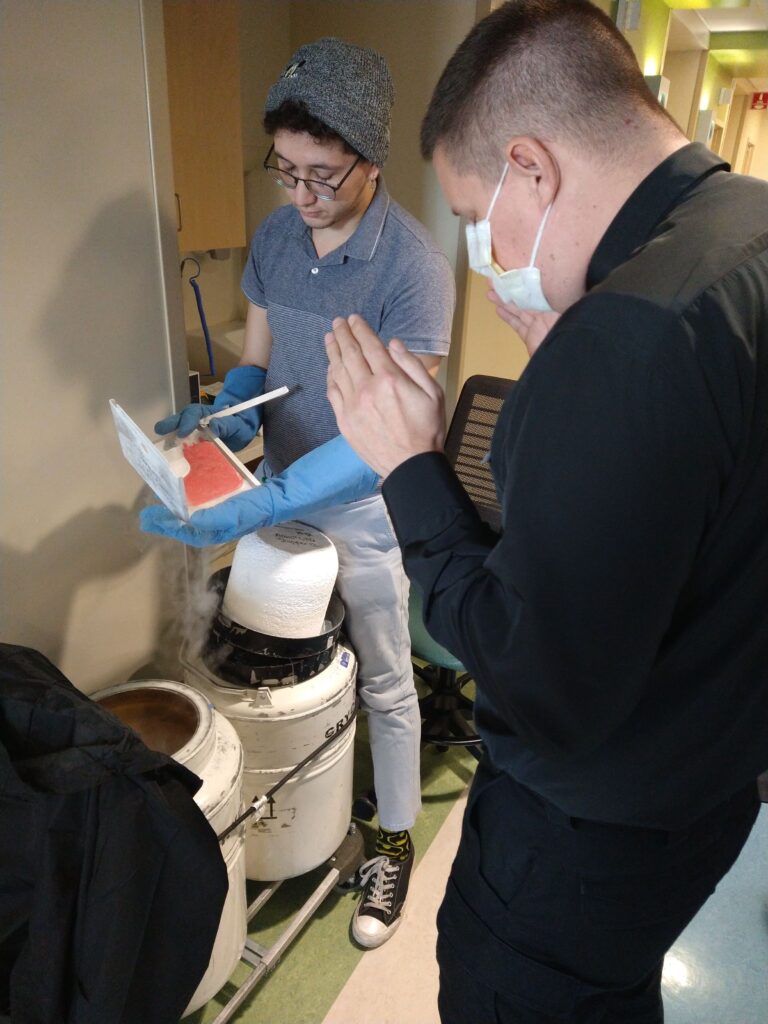By Juraj Koska

“The Vitalant personnel brought a liquid nitrogen tank with 4 bags of donor cells. They were collected elsewhere in the country from the donor’s blood by apheresis (the same procedure Thomas had for lymphocyte collection for CAR Ts), frozen, and shipped and stored at a very low temperature.“
Thomas checked into the hospital on January 23rd. He was in a good shape after several hikes to the local mountains, including a short run on his “grand finale” outing. The next day after the admission, he started a 3-day treatment with ATG (anti-thymocyte globulin), which is a protein isolated from rabbits that were “infected” with human thymocytes. Thymocytes are cells that mature into T-lymphocytes. ATG effectively suppressed T-lymphocyte production in Thomas’ body, including those engineered by the CAR procedure. They did their job but had to go. With no T-lymphocytes, the stem cells from the donor will be able to engraft without being recognized by T-lymphocytes as “xenos”. Thomas experienced a typical fever reaction to these on the first day but had no symptoms for the next 2 days. He was able to use the stationary bike he got in his room and do some exercise as well. Over the weekend he had chemotherapy with a high dose of methotrexate. This made him really sick, especially on the second day and the day after. From Monday to Wednesday, he was transported twice a day by ambulance to Mayo Clinic to receive whole body radiation. The goal for both chemo and radiation was to wipe out his bone marrow cells to make room for the stem cells from the donor. Other than broken AC on one afternoon ride that happened to be on an unseasonably warm winter day in Phoenix (85 degrees F) and bumps from the potholes in the middle lane of Northbound SR-51 just south of the Northern exit, the rides were uneventful with some pleasant crews.
Upon finishing the last radiation session, the staff prepared a little celebration for Thomas ringing the bell (hopefully the last one there and more to come elsewhere), received a certificate of completion and was given a pair of new Jordans. On Thursday he had a rest day. His appetite wasn’t great, but he was still able to eat some meals and do some exercises. He also started a Tacrolimus infusion that will be given for several weeks to prevent rejection of the new bone marrow from the donor. The C-(as in cells)-Day, also Day 0, was set on Friday, February 2nd at 10 am. The routine was the same as for the CAR Ts. The Vitalant personnel brought a liquid nitrogen tank with 4 bags of donor cells. They were collected elsewhere in the country from the donor’s blood by apheresis (the same procedure Thomas had for lymphocyte collection for CAR Ts), frozen, and shipped and stored at a very low temperature. Father Arthur came again in the morning to bless the cells.

Again, the whole assembly of people was present in Thomas’ room once the cells were ready for infusion, including Thomas’s parents, older brother and great-aunt, Fr. Arthur, a doctor, nurse practitioner, child life specialist and two nurses who were hooking up the bags, running the pumps and checking on Thomas’ vitals. Thomas was informed that he would be smelling from the preservative that is kept in the bag to keep cells intact and that his urine may be reddish for the next day or two from the red blood cell remnants in the bags. We were told that some people perceive the smell as garlic, others as tomato soup and others as creamed corn.
Thomas’ brother entertained the crowd with some answers to riddles posted by the child life specialist Jessica. The infusion took 54 minutes, the urine turned red, and Thomas smelled like creamed corn for the next couple of days. On days 1, 3 and 6 he got another dose of methotrexate to suppress what was left in his immune system. We were also told that almost all patients will develop severe mouth sores during the first week and that they need to be fed by tube. So far, Thomas has only mild mouth sores and is still able to eat, though slowly and in smaller amounts because of lack of appetite and mild nausea. He also hasn’t developed a fever yet, another early post- transplant symptom, though his temperature is lingering in the upper subfebrile end.
On day 4 he reached an official nadir of zero white blood cells, and his platelets followed suit. He received the first bag of platelets on Wednesday and then a couple more on Thursday and Friday. On Friday, he also needed a blood transfusion. Normally, it takes 2-3 weeks for the new stem cells to start turning into mature blood cells, so we are about a third to half-way to get to that point. There will be more blood products needed and more adverse effects. The typical hospital stay after bone marrow transplant is about 6-8 weeks, so we are praying for the lower end of 4 more weeks. Now, it’s time to watch some golf, and some hockey, and more golf, and….
